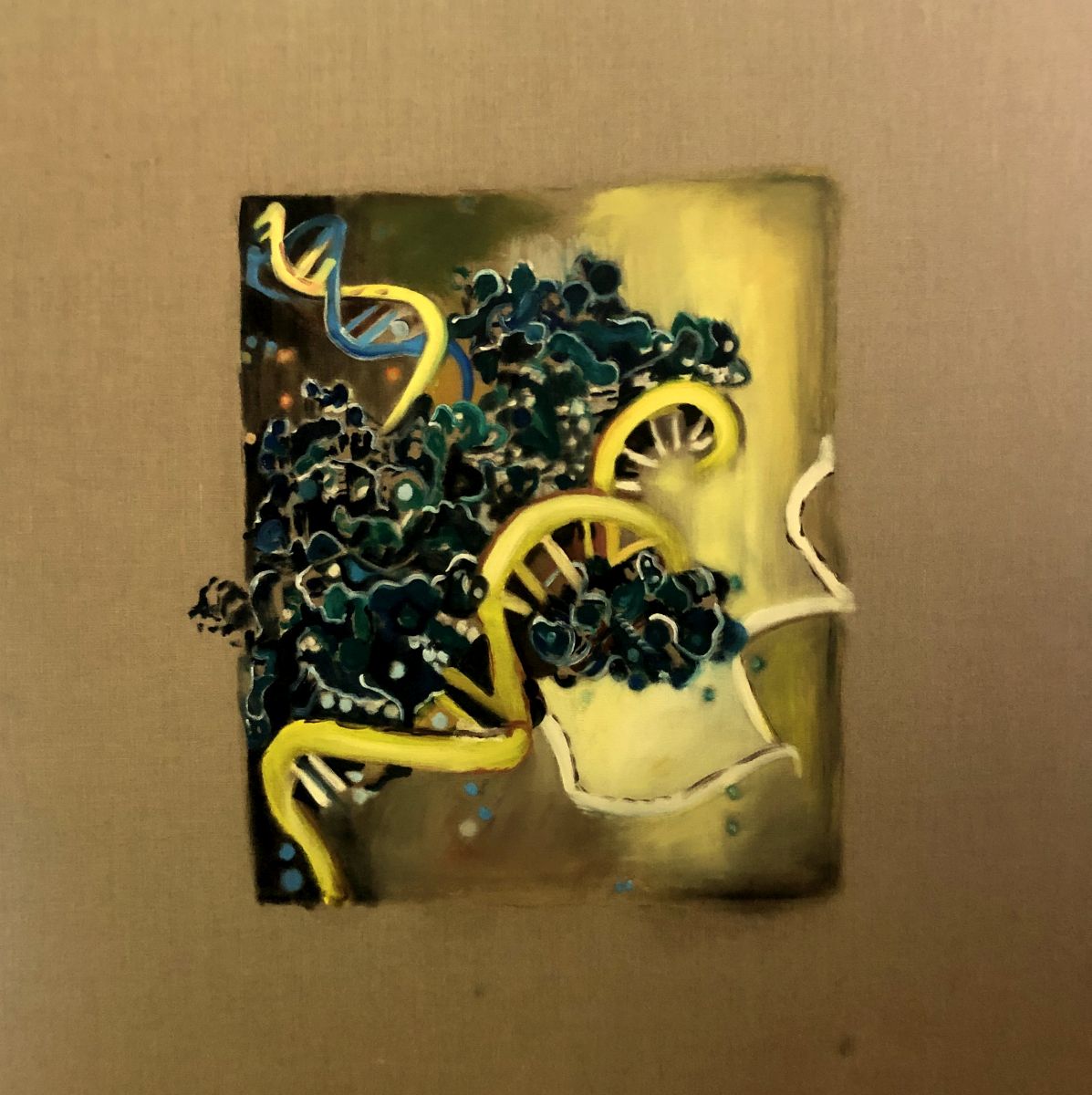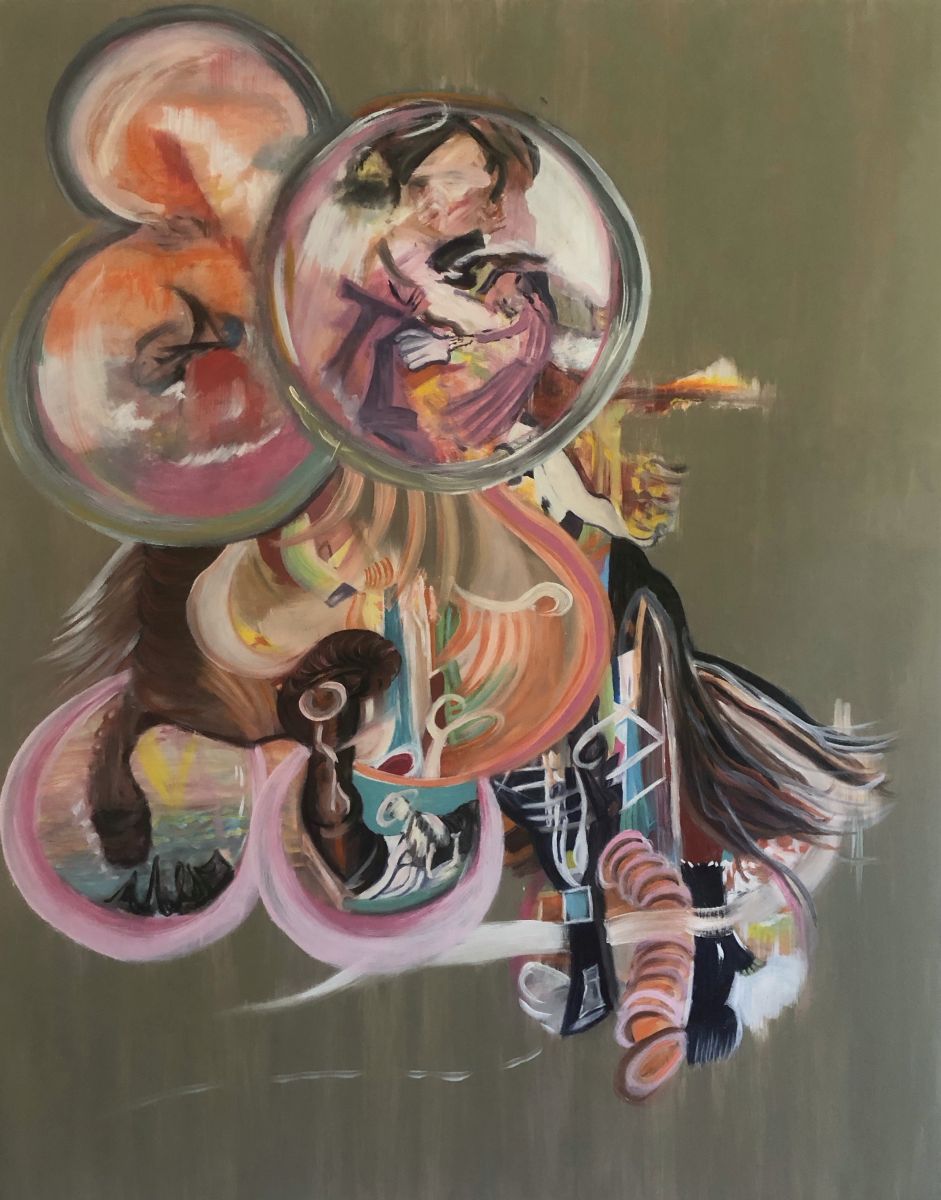Tatyana von Leys
Mitglied des BBK
Berufsverband Bildender Künstlerinnen und Künstler München und Oberbayern e.V.

Artist Statement
Das Streben nach Verbindungen und Affirmationen ist ein wesentlicher Teil unserer Praxis.
Der Begriff 'Posthuman Studies' ist ein interdisziplinärer Forschungsbereich, in dem es um Fragen der menschlichen Identität und den Veränderungen durch den technologischen, digitalen und kulturellen Wandel geht.
Dies spiegelt sich in meinen Arbeiten 'Posthuman Studies after Arthistory', besonders im
Zusammenspiel mit Arbeiten aus der Molekularbiologie wider. Die meisten figurativen
Werke sind in Anlehnung an große Meister wie Velasquez, Ingres und andere entstanden,
verfremdete Portraits aus der Europäischen Kunstgeschichte, die für sich sprechen oder im
Zusammenspiel mit Arbeiten aus der Molekularbiologie, 'Posthumane Verstrickung' auf
ein 'Non Dualistic Thinking' hinweisen.
Alle Arbeiten können natürlich auch für sich alleine betrachtet werden.
Die Kuratorin Lily von Fürstenow in einem Essay über Tatyana von Leys: ...Die Künstlerin bietet uns in ihrem zeitgenössischem Zyklus von Portraits und Arbeiten aus der Molekularbiologie einen beeindruckenden Reichtum an Interpretationen und Sichtweisen in Verbindung zum Trans- und Posthumanismus. Der Umgang mit den Portraits aus der Kunstgeschichte erinnert an die künstlerische Praxis von Francis Bacon, dessen berühmte Portraits mit den für den Künstler typischen Verzerrungen die dunkleren psychologischen Dramen der Portraitierten in den Mittelpunkt stellen. Dagegen ist bei Tatyana von Leys eine humorvolle Sichtweise in vielen ihrer Werke nicht zu übersehen...
Stefan Lorenz Sorgner stellt im Buch HOMO EX MACHINA den Transhumanismus als eine der bedeutendsten gegenwärtigen kulturellen Strömungen dar, spricht in einem Kapitel von einer transhumanistisch orientierten Kunstszene, die speziell in Kontinental-Europa ihre Ursprünge nimmt. Er nennt einige Künstler*innen bei Namen, darunter auch Tatyana von Leys.
The quest for connections and affirmations is a fundamental aspect of our practice
The term 'Posthuman Studies' refers to an interdisciplinary field of research that explores
questions of human identity and the changes brought about by technological
transformation. This is reflected in my work 'Posthuman Studies after Arthistory',
particulary in the intersection with molecular biology. Most of m figurative works pay
homage to the great masters, such as Velasquez, Ingres and others.
Alienated portraits from European art history that stand on their own or resonate in
dialogue with works from molecular biology, Posthuman entanglements that gesture
towards 'Nondualistic Thinking'.
Each work can also be seen on its own.
The curator Lily von Fürstenow in an essay: The artist offers us an impressive wealth of
interpretations and perspectives in her contemporary cycle of portraits and works of
molecular art, in connection to Trans- and Posthumanism. The handling of the portraits
from art history recalls the artistic practice of Francis Bacon, whose famous portraits with
their characteristic distortions bring the darker psychological dramas of the painted
people.
In contrast Tatyana's works often reveal a funny perspective that is hard to miss.
Stefan Lorenz Sorgner: In his book HOMO EX MACHINA he portrays transhumanism as major contemporary movement, highlighting a transhumanist art scene that has its roots specifically in continental Europe. He names in this sense 4 artists, including Tatyana von Leys.

Filme
Max-Planck-Institut für Biochemie (Biologische Intelligenz), Planegg/München, 'Connections'
Ausgewählte Arbeiten / selected paintings
Molecular Art
Oil on canvas

100 x 100 cm, oil on canvas

100 x 70 cm, oil on canvas

120 x 120 cm, oil on canvas
Posthuman Studies after Art History
Oil on canvas

oil on canvas

2025, 100 x 70 cm, oil on canvas

130 x 100 cm, oil on canvas
Portraits
Oil on canvas

60 x 60 cm, oil on canvas

2024, 60 x 50 cm, oil on canvas
Vita

Tatyana von Leys was born around 1960 in Innsbruck/Tyrol. After studying French and philosophy, she worked for a goldsmith for five years.
Accompanied by self-study of painting, she had her first exhibition in Tyrol 1989, where curator and Art Publisher Peter Weiermair became aware off her. Joint projects, exhibitions and publications followed. (e.g. exhibition during the Alpbacher Kulturforum ‚Transite‘, e.g. Book ‚Modern Times‘ – Gallery Krinzinger/Vienna…Tatyana Wirth)
Numerous exhibitions at home and abroad accompany her path. From the beginning, it was the representation of the body in all its diversity and her special style. In the recent years the philosophy of trans- and posthumanism flows into her work by creating connections with works from molecular biology.
Tatyana von Leys plays an important role in the field of trans- and posthumanism, highlighted by Prof. Dr. Stefan Lorenz Sorgner, who named her as artist in the field of Euro Transhumanism, which refers to the European culture in philosophy, History Art, music, etc. She turns art history on its head and packs figures from it with ideas from trans- and posthumanism.
She also made a name for herself as a portrait painter and author and is a single mom of 3 adult kids, full of love and care.
Her works are exhibited in a museum as well as in public and private collections.
Ausstellungsliste / exhibitions
Wichtigste Einzelaustellungen
| 1989 | Galerie Unterberger, Innsbruck |
| 1989 | Galerie (Kunsthaus) Hosp, Tirol (mit Dr. Theo Braunegger-Kultur ORF Tirol) |
| 1989 | Mirabell, Salzburg |
| 1993 | Galerie (Kunsthaus) Hosp, Tirol (mit Dr. Theo Braunegger-Kultur ORF Tirol) |
| 1993 | Kulturforum Weissenbach in Tirol |
| 1996 | Galerie (Kunsthaus) Hosp, Tirol |
| 1997 | Galerie Gottfried Schmidt, Alpbach, Peter Weiermair Katalog und Eröffnung im Rahmen des European Forum Alpbach |
| 2000 | AK-Bildungshaus Seehof, Innsbruck (Peter Weiermair Eröffnung) |
| 2000 | Galerie Walsch, Wien |
| 2000 | Galerie Kranister, Klosterneuburg, Wien |
| 2000 | Galerie Salmana, Wien |
| 2001 | Galerie Dida, Graz |
| 2014 | Kunstbiennale Westtitol, Exhibition 'Portraits' |
| 2022 | Städt. Galerie Theodor von Hörmann, Imst/Tirol 'Tanshumane Verstrickung' |
| 'Tirol aktuell'-Fernsehen, Interview mit Künstlerportrait | |
| 2024 | Max Planck Institut für Biochemie und Biologische Intelligenz, München/Planegg |
| 2024 | BURN-in Galerie, Wien (Österreichischer Galerieverband) |
Wichtigste Gruppenaustellungen
| 1992 | Kulturtage Reutte, Ausstellung im Grünen Haus |
| 1994 | Stadtgalerie Goldener Engel, Hall in Tirol |
| 1994 | Allgäuer Kulturtage, Deutschland |
| 1996 | Museum von Odessa |
| 1998 | Art Expo, New York |
| 2003 | Haus Wien Energie (einst wichtige Kulturstädte mit Künstlern wie Attersee etc.) |
| 2004 | Artware/Kunstauktion, Wien, (Mag. Andrea Jungmann von Sotheby's) |
| 2014 | Kunststraße Imst, Tirol |
| 2017 | Herbstausstellung, Städt. Galerie Theodor von Hörmann, Imst/Tirol |
| 2021 | Emerging Artitst, kuratiert von Dr. phil. Lily von Fürstenow (Kuratorin des X-treme Women Xrt Prize, beteiligt 2025 als Kuratorin im Frauenmuseum Bonn: 'Steine rollen für den Frieden' |
| 2022 | Kunsthaus Graz 'Zur Zukunft des Körpers' - Alfred Nordmann/Tatyana von Leys |
Sammlungen:
Österr. Künstler nach 1945 im Dr. Klocker Museum, Hall in Tirol
Sammlung des Landes Tirol, der Stadt Innsbruck und der Stadt Imst, sowie in diversen Instituten
Einige Werke auf ARTSY,
der Kunstplattform
genannt in akademischen Arbeiten von Prof. Dr. phil. Stefan Lorenz Sorgner, Dr. Maurizio Balistreri,
sowie in akademischen Vorträgen über Trans- und Posthumanismus
im Buch HOMO EX MACHINA,
Kapitel Eurotranshumanismus von Stefan Lorenz Sorgner
| 2025 | Aufnahme in den BBK, Berufsverband Bildender Künstlerinnen und Künstler, München und Oberbayern e.V. |
Veröffentlichungen / publications
- Essay für die Universität Innsbruck/WuV-Arbeitskreis Wissenschaft und Verantwortlichkeit 'Beschleuniger in eine transhumane Zukunft' 2020 https://wwwuibk.ac.at 2020
- Kunstleben Berlin-das Kunstmagazin https://www.kunstleben-berlin.de Die Menschheit an der Schwelle zu einer neuen Realität/Kolumne von Ludwig Graf Westarp Portrait der Künstlerin Tatyana von Leys 2021
- Tagree Magazine 2023
- Modern Times/Galerie Krinzinger, Wien (im Bookshop der Galerie zu bestellen)
- Tiroler Tageszeitung
- Wiener Zeitung
- transform/Magazin für den digitalen Wandel
- 'das kleine Buch zum neuen Denken/Technik ist Evolution neu gedacht' by myself 2018
- Galerie Theodor von Hörmann, Imst in Tirol
- in zahlreichen akademischen Arbeiten von Stefan Lorenz Sorgner und anderen erwähnt
- Buch 'Homo ex Machina' - Eurotranshumanism by Stefan Lorenz Sorgner

Contact
If you're interested in acquiring an artwork, getting more information or knowing what is available, please contact me using the links or the form below.
Do you like an artwork or are you thinking about commissioning a custom piece or portrait? Please contact me via instagram or e-mail now. Happy to chat!
Impressum / imprint
Tatyana von Leys
Sonnenbichlweg 14
83707 Bad Wiessee
info@tatyana-leys.com
Tel. international: +49 | 172 | 86 12 552
Tel. national: 0172 | 86 12 552
eMail: info [at] tatyana-leys.com
Web: tatyana-von-leys.com
Copyright
Sämtliche Inhalte dieser Website, insbesondere Texte, Fotos, Grafiken, Programmierung und Layout sind urheberrechtlich geschützt. Das Kopieren oder die Reproduktion der Website als Ganzes oder in Teilen ist nicht gestattet. Für etwaige Satzfehler und die Richtigkeit der Inhalte dieser Website sowie die Inhalte verlinkter, externer Internetpräsentationen übernehmen die Autoren keinerlei Haftung oder Gewähr.
Text & Fotografie by: Tatyana von Leys
© 2025 Tatyana Leys

